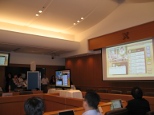Web on TV workshop in Japan

In the long series of workshops organized by W3C, the Web on TV workshop is currently ongoing at Keio University, in Tokyo, Japan. This is not a new subject at W3C, we also organized a workshop on television and the Web back in June 1998.
The 2010 workshop brings TV broadcasters, device makers, and Web companies at the same table. Around 130 participants are attending the workshop, making it the biggest W3C workshop ever. We have a large panel of companies coming from different industries, like NHK, TV tokyo, Samsung, Hitachi, Canon, NEC, Cisco, Ericsson, Opera, Microsoft, Intel, NTT, Sony, or Technicolor.
In the past 12 years, a profile of HTML has been deployed in digital TV. In Japan, BML, done at the IPTV forum Japan, was first released in 1999. There are around 80 millions digital TV units and 20% of them are connected to IP. Japan will switch from analog to digital only next year. With BML support, you can access the data broadcast to read weather or emergency information, participate in a TV quizz, see twitter comments during elections, etc. ITU-T is working on their own standard, H 762 (called LIME), as well.
The main topic of the workshop is how, going forward, we apply Web technologies, in particular HTML5, to the television set. Whether we need more APIs to support their use cases, provide support for remote controls, enable more personalization, take into account parental control, etc. Interestingly, the topic of accessibility, which is a hot topic within the HTML Working Group, is also an important topic for Web on TV.
The workshop isn't over yet and I'm already looking forward for the next steps.
Mr. Akwasi Kuranchie Nkyi
TV Producer Director -Ghana Broadcasting Corporation and interested in participating in the ocurse so how i can join
well television in Ghana seeks to educate, inform and entertain. the public broadcaster that is Ghana Broadcasting Corporation has always being the trustworthy mouth piece and the voice for the society and the nation as whole. but needs more training interms of resources, so some of this should reach sub sara Africa